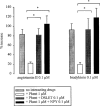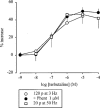Enhancement of noradrenaline release by angiotensin II and bradykinin in mouse atria: evidence for cross-talk between G(q/11) protein- and G(i/o) protein-coupled receptors
- PMID: 10725257
- PMCID: PMC1571946
- DOI: 10.1038/sj.bjp.0703167
Enhancement of noradrenaline release by angiotensin II and bradykinin in mouse atria: evidence for cross-talk between G(q/11) protein- and G(i/o) protein-coupled receptors
Abstract
1. The interaction between alpha(2)-autoreceptors and receptors for angiotensin (AT(1)) and bradykinin (B(2)) was studied in mouse isolated atria. The preparations were labelled with [(3)H]-noradrenaline and then superfused with desipramine-containing medium and stimulated electrically. 2. Angiotensin II (10(-11) - 10(-7) M), angiotensin III (10(-10) - 10(-6) M) and bradykinin (10(-11) - 10(-7) M) enhanced the evoked overflow of tritium when preparations were stimulated with conditions that led to marked alpha(2)-autoinhibition (120 pulses at 3 Hz), but not when stimulated with conditions that led to little alpha(2)-autoinhibition (20 pulses at 50 Hz). 3. Blockade of alpha-adrenoceptors by phentolamine (1 or 10 microM) reduced or abolished the effect of angiotensin II and bradykinin on the overflow response to 120 pulses at 3 Hz. 4. Addition of the delta-opioid agonist [D-Ser(2)]-leucine enkephalin-Thr (DSLET, 0.1 microM), or of neuropeptide Y (0.1 microM), together with phentolamine, restored the effect of angiotensin II and bradykinin. 5. The beta-adrenoceptor agonist terbutaline (10(-9) - 10(-4) M) enhanced the evoked overflow of tritium irrespective of the degree of autoinhibition. 6. The experiments show that (i) a marked prejunctional facilitatory effect of angiotensin and bradykinin in mouse isolated atria requires prejunctional alpha(2)-autoinhibition; (ii) in the absence of alpha(2)-autoinhibition, activation of other prejunctional G(i/o) protein-coupled receptors, namely opioid and neuropeptide Y receptors, restores a marked effect of angiotensin II and bradykinin; and (iii) the facilitatory effect of terbutaline is not dependent upon the degree of alpha(2)-autoinhibition. The findings indicate that the major part of the release-enhancing effect elicited through prejunctional G(q/11) protein-coupled receptors is due to disruption of an ongoing, alpha(2)-autoreceptor-triggered G(i/o) protein mediated inhibition.
Figures





Similar articles
-
Crosstalk between presynaptic angiotensin receptors, bradykinin receptors and alpha 2-autoreceptors in sympathetic neurons: a study in alpha 2-adrenoceptor-deficient mice.Br J Pharmacol. 2003 Apr;138(8):1389-402. doi: 10.1038/sj.bjp.0705223. Br J Pharmacol. 2003. PMID: 12721093 Free PMC article.
-
Involvement of G-protein βγ subunits on the influence of inhibitory α2-autoreceptors on the angiotensin AT1-receptor modulation of noradrenaline release in the rat vas deferens.Neurochem Int. 2006 Dec;49(7):698-707. doi: 10.1016/j.neuint.2006.07.002. Epub 2006 Sep 7. Neurochem Int. 2006. PMID: 16962210
-
Functional crosstalk of prejunctional receptors on the modulation of noradrenaline release in mesenteric vessels: A differential study of artery and vein.Eur J Pharmacol. 2011 Feb 10;652(1-3):33-9. doi: 10.1016/j.ejphar.2010.10.075. Epub 2010 Nov 27. Eur J Pharmacol. 2011. PMID: 21114976
-
Prejunctional effects of angiotensin II and bradykinin in the heart and blood vessels.J Auton Pharmacol. 1999 Dec;19(6):321-5. doi: 10.1111/j.1365-2680.1999.tb00004.x. J Auton Pharmacol. 1999. PMID: 10961737 Review.
-
Regulatory proteins in presynaptic function.Ann N Y Acad Sci. 1990;604:289-304. doi: 10.1111/j.1749-6632.1990.tb32001.x. Ann N Y Acad Sci. 1990. PMID: 2171397 Review.
Cited by
-
Differential contributions of alpha-1 and alpha-2 adrenoceptors to vasoconstriction in mesenteric arteries and veins of normal and hypertensive mice.Vascul Pharmacol. 2007 May;46(5):373-82. doi: 10.1016/j.vph.2007.01.003. Epub 2007 Jan 27. Vascul Pharmacol. 2007. PMID: 17329171 Free PMC article.
-
Release inhibitory receptors activation favours the A2A-adenosine receptor-mediated facilitation of noradrenaline release in isolated rat tail artery.Br J Pharmacol. 2002 May;136(2):230-6. doi: 10.1038/sj.bjp.0704686. Br J Pharmacol. 2002. PMID: 12010771 Free PMC article.
-
Invited Lectures : Overviews Purinergic signalling: past, present and future.Purinergic Signal. 2006 May;2(1):1-324. doi: 10.1007/s11302-006-9006-2. Epub 2006 May 15. Purinergic Signal. 2006. PMID: 18404494 Free PMC article. No abstract available.
-
Angiotensin AT1 - α2C-Adrenoceptor Interaction Disturbs α2A-auto-Inhibition of Catecholamine Release in Hypertensive Rats.Front Neurol. 2013 Jun 10;4:70. doi: 10.3389/fneur.2013.00070. eCollection 2013. Front Neurol. 2013. PMID: 23772221 Free PMC article.
-
Influence of alpha2-autoreceptor stimulation on the facilitation by angiotensin II and bradykinin of noradrenaline release.Naunyn Schmiedebergs Arch Pharmacol. 2003 Dec;368(6):443-7. doi: 10.1007/s00210-003-0840-2. Epub 2003 Nov 26. Naunyn Schmiedebergs Arch Pharmacol. 2003. PMID: 14647975
References
-
- BELL C. Mechanism of enhancement by angiotensin II of sympathetic adrenergic transmission in the guinea pig. Circ. Res. 1972;31:348–355. - PubMed
-
- BRASCH H. Field stimulation-induced noradrenaline release from guinea-pig atria is modulated by prejunctional α2-adrenoceptors and protein kinase C. Basic Res. Cardiol. 1993;88:545–556. - PubMed
-
- BRASCH H., SIEROSLAWSKI L., BERGMANN N., DOMINIAK P.In field-stimulated guinea-pig atria an AT1-receptor mediated increase of noradrenaline release by angiotensin II is seen only in the presence of prejunctional autoinhibition Tissue renin-angiotensin systems 1995Plenum Press: New York; 293–298.eds. Mukhopadhyay, A.K. & Raizada, M.K. pp - PubMed
-
- BROCK J.A., CUNNANE T.C., STARKE K., WARDELL C.F. α2-Adrenoceptor-mediated autoinhibition of sympathetic transmitter release in guinea-pig vas deferens studied by intracellular and focal extracellular recording of junction potentials and currents. Naunyn-Schmiedeberg's Arch. Pharmacol. 1990;342:45–52. - PubMed
Publication types
MeSH terms
Substances
LinkOut - more resources
Full Text Sources
Other Literature Sources
Research Materials

